 The title sounds like a contradiction in terms. Ketogenic diets are associated with eating lots of fatty meats, cheeses, eggs, and nuts. Vegetarian diets, on the other hand, are associated with lots of steamed vegetables, salads, legumes, whole grains, and wheatgrass juice. On the surface, these appear to be at opposite ends of the diet spectrum. As far as the energy in relation to biochemistry is concerned, they use opposite energy sources – ketogenic diets get their energy from fats while vegetarian diets get their energy from sugars and carbohydrates. At least that is how average writings on the subjects present it. Let’s look a little deeper because reality is always so much more complex and interesting.
The title sounds like a contradiction in terms. Ketogenic diets are associated with eating lots of fatty meats, cheeses, eggs, and nuts. Vegetarian diets, on the other hand, are associated with lots of steamed vegetables, salads, legumes, whole grains, and wheatgrass juice. On the surface, these appear to be at opposite ends of the diet spectrum. As far as the energy in relation to biochemistry is concerned, they use opposite energy sources – ketogenic diets get their energy from fats while vegetarian diets get their energy from sugars and carbohydrates. At least that is how average writings on the subjects present it. Let’s look a little deeper because reality is always so much more complex and interesting.
 A good example that has been so well studied for the last 60 years is energy use in muscles. At rest and during mild exercise about half the energy used comes from burning fats directly and the other half from burning sugar. The more intense the exercise, the less the energy comes from fat burning. This is in part because fat burning needs oxygen and as exercise gets more intense, we can’t get oxygen to the tissues fast enough. In contrast, the heart gets more than 70% of its energy from burning fats. The rest comes from ketones, glucose, lactate, and amino acids. Because we might use voluntary muscles in quick bursts of energy that override oxygen availability, we actually store a form of sugar called glycogen in muscles. This and the liver are the only places in the body where we store sugar. The brain, on the other hand, never burns fat for energy. Fat molecules are too big to get across the blood-brain barrier. Only sugar and ketones get across that barrier to feed the brain.
A good example that has been so well studied for the last 60 years is energy use in muscles. At rest and during mild exercise about half the energy used comes from burning fats directly and the other half from burning sugar. The more intense the exercise, the less the energy comes from fat burning. This is in part because fat burning needs oxygen and as exercise gets more intense, we can’t get oxygen to the tissues fast enough. In contrast, the heart gets more than 70% of its energy from burning fats. The rest comes from ketones, glucose, lactate, and amino acids. Because we might use voluntary muscles in quick bursts of energy that override oxygen availability, we actually store a form of sugar called glycogen in muscles. This and the liver are the only places in the body where we store sugar. The brain, on the other hand, never burns fat for energy. Fat molecules are too big to get across the blood-brain barrier. Only sugar and ketones get across that barrier to feed the brain.
 So, you see the reality is so much more complex and interesting than diet books would have you believe. Every body tissue uses a different mix of energy sources normally. The liver is always producing different fuels for our tissues to burn from whatever we are eating. For example, we are taught that the protein we eat is used to build muscles and skin. In truth, 90% of the protein we eat is turned into either sugar or fat by the liver. Only 10% ends up being used to build tissues on average. Everything said has to be as an average, because what happens actually changes all day long rhythmically with our circadian hormones and under the influence of various other hormones.
So, you see the reality is so much more complex and interesting than diet books would have you believe. Every body tissue uses a different mix of energy sources normally. The liver is always producing different fuels for our tissues to burn from whatever we are eating. For example, we are taught that the protein we eat is used to build muscles and skin. In truth, 90% of the protein we eat is turned into either sugar or fat by the liver. Only 10% ends up being used to build tissues on average. Everything said has to be as an average, because what happens actually changes all day long rhythmically with our circadian hormones and under the influence of various other hormones.
 So what does this have to do with keto-vegetarian diet considerations? Well, starting about the end of October in this country, the average person’s metabolism experiences something like a slow-motion train wreck. The days start getting shorter and colder, so we get out and move less and therefore, burn less sugar. On top of that, we start consuming more sugar. Sugar beyond about 15 – 20 grams per day, for the average person, is toxic. The fructose in the sugar starts damaging the liver and what frequently happens is that this screws up the fine regulation the liver has on the delicate balance of energy sources it generates to put into the blood to feed all the various tissues. We will start to notice this as spots of tiredness in the middle of the day, brain fog, craving for sweets, feeling the need for coffee or tea, irritability, hungry even though you have just eaten, and other stuff. We often develop a liver-based blood sugar problem where the minute-to-minute blood sugar levels is not properly regulated. This is not the more popularly known pancreas problem of diabetes or low blood sugar. No, this is a different kind of blood sugar regulation problem they didn’t tell you about in school.
So what does this have to do with keto-vegetarian diet considerations? Well, starting about the end of October in this country, the average person’s metabolism experiences something like a slow-motion train wreck. The days start getting shorter and colder, so we get out and move less and therefore, burn less sugar. On top of that, we start consuming more sugar. Sugar beyond about 15 – 20 grams per day, for the average person, is toxic. The fructose in the sugar starts damaging the liver and what frequently happens is that this screws up the fine regulation the liver has on the delicate balance of energy sources it generates to put into the blood to feed all the various tissues. We will start to notice this as spots of tiredness in the middle of the day, brain fog, craving for sweets, feeling the need for coffee or tea, irritability, hungry even though you have just eaten, and other stuff. We often develop a liver-based blood sugar problem where the minute-to-minute blood sugar levels is not properly regulated. This is not the more popularly known pancreas problem of diabetes or low blood sugar. No, this is a different kind of blood sugar regulation problem they didn’t tell you about in school.
 The only answer to this problem is to give that liver a rest from sugars and carbs for a while so it can heal. I use a particular type of spinal stimulation to re-initiate this process. I then put folks on a carb-restricted diet for 4 to 6 weeks. I suspect that we could still get the results without the spinal correction, but the liver rest time might be more like 12 weeks. I have used this protocol successfully for over 40 years, and it is fairly easily adapted to vegetarians. This is the keto-vegetarian diet I titled this article on. But every now and then I have a patient who is a Vegan, and basically correcting this problem becomes very difficult in this situation… impossible in fact unless a number of supplements are used along with the diet. More about those special needs in a moment.
The only answer to this problem is to give that liver a rest from sugars and carbs for a while so it can heal. I use a particular type of spinal stimulation to re-initiate this process. I then put folks on a carb-restricted diet for 4 to 6 weeks. I suspect that we could still get the results without the spinal correction, but the liver rest time might be more like 12 weeks. I have used this protocol successfully for over 40 years, and it is fairly easily adapted to vegetarians. This is the keto-vegetarian diet I titled this article on. But every now and then I have a patient who is a Vegan, and basically correcting this problem becomes very difficult in this situation… impossible in fact unless a number of supplements are used along with the diet. More about those special needs in a moment.
 We have survived through Thanksgiving and the holiday eating season is now in full swing. The body purposefully goes into an inflammatory metabolic syndrome this time of year in order to put on as much fat weight as possible to help us survive the famine that it believes is coming in January, February, and March. For the true naturalists among you, these are the best months for fasting. So many of you are already starting to experience some of those blood sugar regulation wobble symptoms. These symptoms are mostly due to the effect of energy supply issues with the brain since it can’t burn fats for energy. This is where ketones come into play. Ketones are made from fats but are tiny by comparison, so they can cross the blood-brain barrier and feed the brain. So your brain is much happier when you are giving your liver a rest from carbs and sugars if you can get your ketone production up high enough to feed the brain.
We have survived through Thanksgiving and the holiday eating season is now in full swing. The body purposefully goes into an inflammatory metabolic syndrome this time of year in order to put on as much fat weight as possible to help us survive the famine that it believes is coming in January, February, and March. For the true naturalists among you, these are the best months for fasting. So many of you are already starting to experience some of those blood sugar regulation wobble symptoms. These symptoms are mostly due to the effect of energy supply issues with the brain since it can’t burn fats for energy. This is where ketones come into play. Ketones are made from fats but are tiny by comparison, so they can cross the blood-brain barrier and feed the brain. So your brain is much happier when you are giving your liver a rest from carbs and sugars if you can get your ketone production up high enough to feed the brain.
 The blood sugar protocol involves basically eating lots of protein, fat, and low-carb veggies. Some low-carb fruit is allowed along with spices, herbs, and vinegars. Through the use of cheese, eggs, nuts, and some other typical vegetarian proteins, this recovery diet for the liver is quite doable. What is prominently missing from this meal plan is any sort of grain, pseudo-grain, tuber, legume, or sugar source. That means no bread, no tortillas, no beans, no rice, no corn, no potatoes, not even sweet potatoes. Even artificial sweeteners are not allowed. This is a low-carb protocol, which is the same thing as a keto diet.
The blood sugar protocol involves basically eating lots of protein, fat, and low-carb veggies. Some low-carb fruit is allowed along with spices, herbs, and vinegars. Through the use of cheese, eggs, nuts, and some other typical vegetarian proteins, this recovery diet for the liver is quite doable. What is prominently missing from this meal plan is any sort of grain, pseudo-grain, tuber, legume, or sugar source. That means no bread, no tortillas, no beans, no rice, no corn, no potatoes, not even sweet potatoes. Even artificial sweeteners are not allowed. This is a low-carb protocol, which is the same thing as a keto diet.
 The only special supplement that vegetarians will need is a source of carnitine and carnosine, which is usually only found in meat. Carnitine is necessary to transport fatty acids into the mitochondria to produce energy and carnosine is important for reversing the damage caused by excess sugar glycating (binding to) proteins in the tissues. Both can be purchased as supplements and are derived from yeast grown in big vats. Carnosine is very expensive and can be boosted by supplementing it with the amino acid beta-alanine, which is much less expensive.
The only special supplement that vegetarians will need is a source of carnitine and carnosine, which is usually only found in meat. Carnitine is necessary to transport fatty acids into the mitochondria to produce energy and carnosine is important for reversing the damage caused by excess sugar glycating (binding to) proteins in the tissues. Both can be purchased as supplements and are derived from yeast grown in big vats. Carnosine is very expensive and can be boosted by supplementing it with the amino acid beta-alanine, which is much less expensive.
 Vegans will have to make some special adaptations since they do not use the protein sources of dairy and eggs. Most vegetables are deficient in various amino acids, and leaving out the grains and legumes means that Vegans will have to find a good Vegan powdered complete protein, such as hemp or pea protein. Duckweed or water lentil is a new and good quality protein. Soy is not a great protein source as it has many health issues associated with it. However, fermenting the soy, as in making tempeh, gets rid of many of those issues.
Vegans will have to make some special adaptations since they do not use the protein sources of dairy and eggs. Most vegetables are deficient in various amino acids, and leaving out the grains and legumes means that Vegans will have to find a good Vegan powdered complete protein, such as hemp or pea protein. Duckweed or water lentil is a new and good quality protein. Soy is not a great protein source as it has many health issues associated with it. However, fermenting the soy, as in making tempeh, gets rid of many of those issues.
 Are there other reasons for going keto if you are a vegetarian? Yes. Normally the brain runs on sugar. Sugar is damaging and tangles the tau fibers which eventually causes dementia. The only way to remove those tangles is through the process of autophagy. In autophagy, the brain can clean itself out by eating up the damaged proteins. But the brain and body will only go into autophagy when there is very low insulin, which only happens during fasting or fast mimicking. Being on a keto diet gives the brain ketones to use for energy and allows it to slip into autophagy easily. Just skip eating protein now and then for the body to slip into autophagy for a bit and clean itself out.
Are there other reasons for going keto if you are a vegetarian? Yes. Normally the brain runs on sugar. Sugar is damaging and tangles the tau fibers which eventually causes dementia. The only way to remove those tangles is through the process of autophagy. In autophagy, the brain can clean itself out by eating up the damaged proteins. But the brain and body will only go into autophagy when there is very low insulin, which only happens during fasting or fast mimicking. Being on a keto diet gives the brain ketones to use for energy and allows it to slip into autophagy easily. Just skip eating protein now and then for the body to slip into autophagy for a bit and clean itself out.
 This is the worst time of the year to try to do a keto diet, as holiday goodies are everywhere and our body wants to eat them. I am hoping that by showing you the way out now, you will have the tools to get back into a healthy path right after the first of the new year.
This is the worst time of the year to try to do a keto diet, as holiday goodies are everywhere and our body wants to eat them. I am hoping that by showing you the way out now, you will have the tools to get back into a healthy path right after the first of the new year.
Take care,
David
